Early Summer Float Trips
Posted on January 23rd, 2024
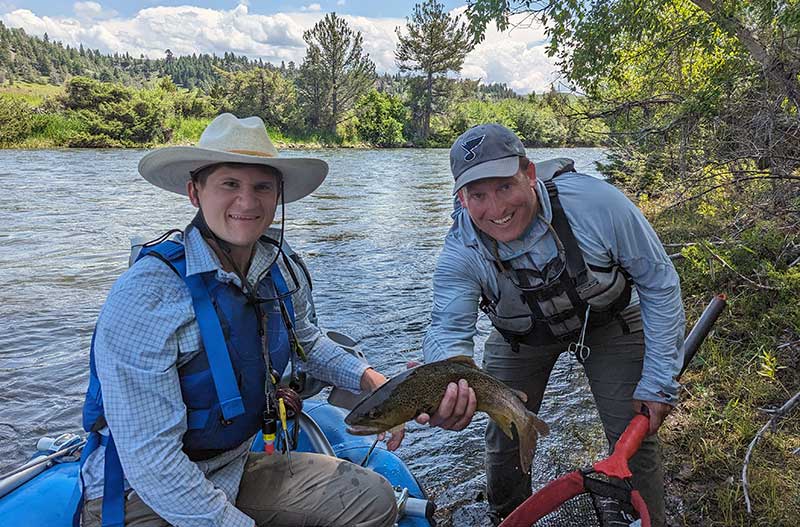
The Boulder River is a prime destination in early summer.
Early Summer Float Trips: Introduction and Quick Facts
Between the middle of June and early July, runoff recedes and the high season begins. The next month or so finds rivers still running high and fast, but clear. Insect hatches are abundant, including the famous Salmonfly, and the trout are eager to eat after a month or more of high, muddy water.
This time of year typically offers the best caddis, stonefly, and attractor dry fly fishing of the season, especially for experienced clients able to hit small targets along the bank while the boat is jetting downriver in the high flows. This period is also a decent time for big fish on floats, especially for clients interested in fishing big nymphs and streamers.
Since the fishing and weather and water conditions are great at this time, it’s little wonder that this is the absolute peak season for float fishing in the region.
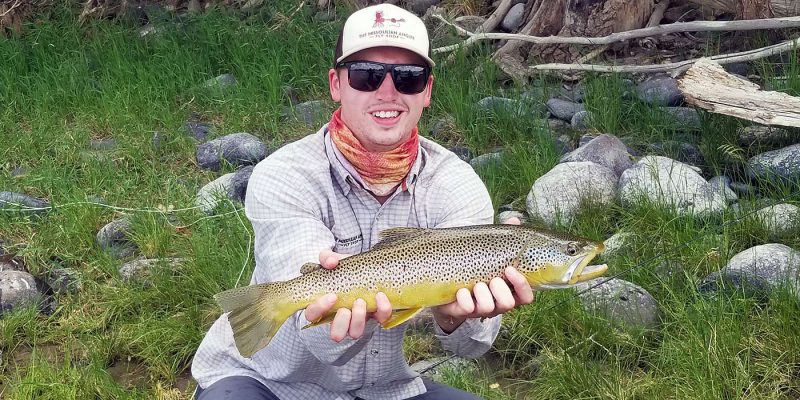
Early summer is an excellent time to target larger brown trout on big nymphs and dead-drifted streamer flies.
- Best Waters: The Yellowstone and Boulder are our favorite float rivers at this time, and with these nearby fisheries all in their prime, we seldom run float trips elsewhere in early summer.
- Three Top Reasons to Come in Early Summer: 1.) This is peak large dry fly time on all rivers, 2.) This time of year offers the most consistent float fishing, if not always the best fishing, and 3.) this period offers the most consistent weather and water conditions of the year.
- Three Top Reasons to Avoid Early Summer: 1.) This is the most crowded time of year, 2.) The fishing is very fast-paced and requires accurate casting, which may be a plus or a minus depending on perspective, and 3.) Late summer and early fall are better for large fish on dry flies, though early summer is better on subsurface flies.
- Perfect Clients: Clients with at least some fly fishing experience who enjoy fast-paced fishing and like to rack up the numbers rather than try to sight-fish or otherwise “hunt” a few big fish (though a few big fish are possible in early summer). Really, early summer is great for all clients except those who want a lazy day and those who can’t stand to see any other anglers on the water.
- What Early Summer Does Best: Early summer provides the best attractor, caddis, and stonefly dry fly and dry-dropper fishing of the season; it’s also a good time for big trout using a few techniques and in a few places, though not generally on dries.
Early Summer Float Trips: The Fishing
Sometime between the middle of June (following dry winters) and early July (following wet winters), freestone rivers begin dropping out of the spring melt. This happens earlier on the Jefferson, Upper Madison, and Boulder, later on the Yellowstone and the lower end of the Stillwater. Just as the water gets a foot or eighteen inches of visibility, usually while the rivers are still up in the bushes and the current is raging, the fish and trout stream insects on which the fish feed go bananas and probably the most consistent fishing of the year begins.
The Yellowstone, Boulder, and Stillwater are our favorite haunts at this time. The upper Madison is also good. In fact, every river in the region is good at least at the beginning of early summer, though some get too warm by mid-July.
All rivers see their most-varied aquatic insect hatches of the year at this time. Many rivers see brief hatches of the fabled Salmonfly (giant black stonefly) for a week or so, but all possess good populations of smaller stoneflies and several species of caddisflies. Some mayflies also hatch on float rivers, especially in slow areas and on the Missouri. This smorgasboard means that attractor patterns are often better than imitations of one specific insect at this time. With so much to choose from, the fish often don’t get particular for any one thing.
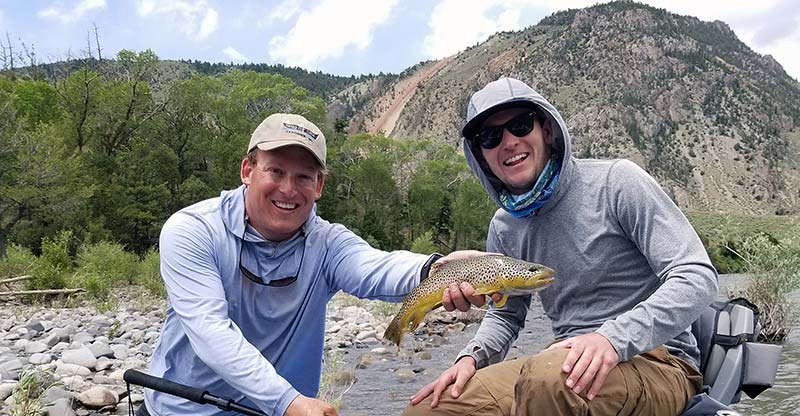
River flows remain high through early summer, often at least grazing the willow bushes and grass throughout this period. Heavy aquatic insect hatches coupled with high flows mean the fish are pushed close to the banks in search of food and to stay out of the current, at least the fish looking to feed on the surface rather than on nymphs and baitfish hiding in the rocks. Therefore, much of the fishing involves making short, accurate casts to shallow water, within a few feet of shore, or right behind midriver rocks that break the surface and therefore cushion the current.
Overall, we have three preferred techniques while guiding at this time. By far our favorite when the fish are cooperative is to fish only dry flies. These might match the various insects that are hatching, large and small, but more often we like to fish various attractors, especially a couple “caddis-like” patterns our outfitter personally developed. Whatever the dry fly, not only is it more fun to see fish rise, but it’s also easier to avoid hanging up in the bushes or the shallow rocks when the fly (or flies) are on the surface and visible.
If the fish aren’t rising well but are doing so occasionally, we will hang a nymph or emerger under a dry. Usually this is a small attractor nymph, a big stonefly, or a caddis pupa.
Our final preferred technique at this time is “drifting and dragging” streamer and nymph combinations. This is indicator nymphing using a streamer pattern with a nymph as a “second chance” fly. Of these three techniques, the last produces the largest fish, while in the right conditions the “dry or die” method produces the most fish.
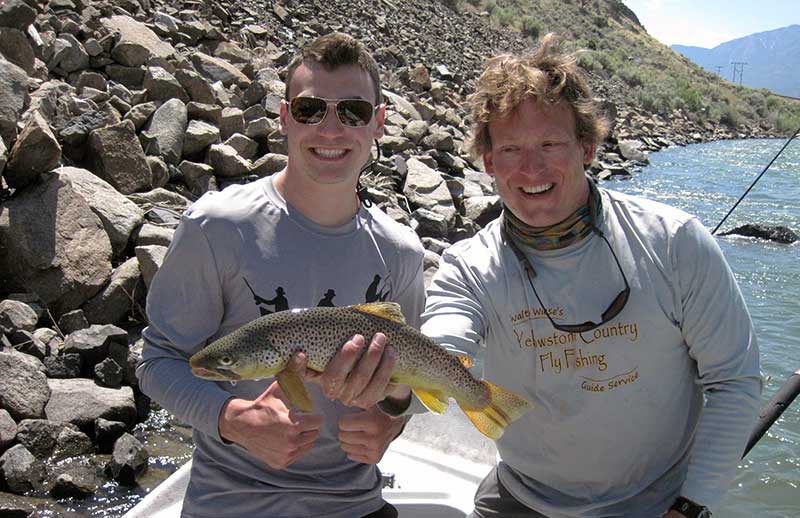
Early summer fishing gets two thumbs up.
This is a wonderful period for experienced anglers who like fast-paced dry fly fishing. The fishing is fast-paced because of the current speed. The slow spots where the trout hold are small, and no matter how hard the guide rows back upstream, most of the time anglers get only one crack at each spot. This is why early summer can be hard for total beginners. Except when floating a few gentle stretches of the Yellowstone within Paradise Valley, the current speed, the small targets, and the many hangups (bushes in the water and rocks) can be frustrating for rookies. That said, rookies who understand things will be fast and furious can still do well, especially when we’re sticking to nymphs. Some of the largest fish that we saw in 2020 were caught by beginner or novice clients in early summer.
Because of the high water that makes wading difficult and also pushes the fish to the same places we’d be standing when wade-fishing, almost all fishing at this time is done from the boat. There are a few areas we might pull into and drop anchor to hit a little harder, and many more we might back into for a few casts, but otherwise almost all fishing in early summer is done while the boat is moving.
>>>>>>>>>>>>>>>>>> Return to Float Trips Page
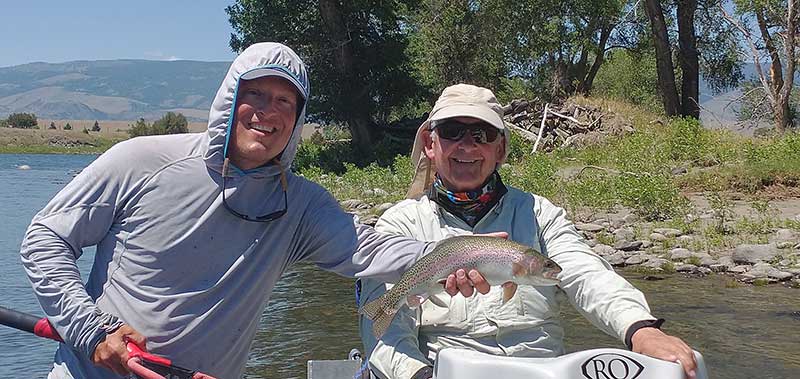
Float Trips in Late Spring
Posted on January 23rd, 2024
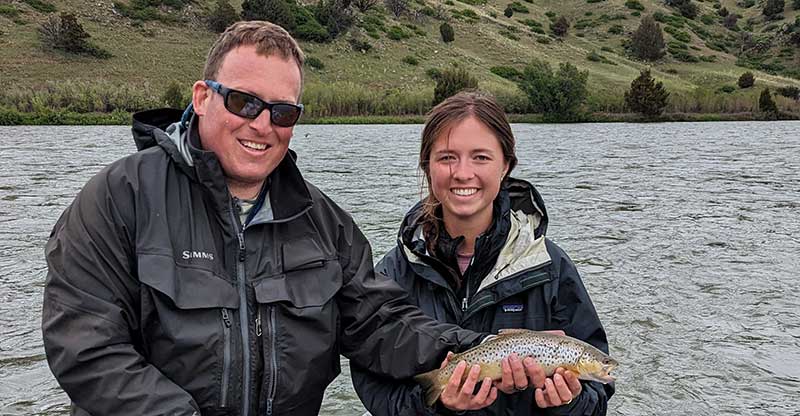
Late spring is prime time on the lower Madison River.
Late Spring Float Trips: Introduction
Late spring, here meaning from the beginning of the heavy spring melt in the first or second week of May through its conclusion in late June or early July, is prime time for trout fishing in many parts of the United States. In the Rockies, it’s not. This is particularly true for anglers who want to float free-flowing rivers like the Yellowstone, Boulder, and Stillwater rather than those right below dams, like the Lower Madison and Missouri.
The issue is the spring melt that raises all area rivers and turns most into raging brown chocolate milkshakes for at least a few weeks. During this timeframe, river float trips turn to tailwaters: the Madison and Missouri Rivers. These rivers downstream of dams stay clear. Therefore all that the high water they experience does is flush lots of insects and other foods into the drift for the trout to gorge on. In contrast to other rivers, tailwater rivers offer great float fishing at this time.
There’s one other factor that can influence fishing in late spring: runoff breaks. Runoff breaks are periods of cool or cold and usually dry weather that pause the spring runoff for a day or two at a time on freestone rivers, particularly the Yellowstone upstream from Livingston and the Boulder.
When a runoff break occurs, the trout in freestone rivers go bananas, feeding heavily on stonefly nymphs and streamers. If you happen to be here in May or the first three weeks of June when flows are dropping and water clarity is 18 inches or more, fishing on freestones can be better than it is almost any other time of year. You just can’t plan for these breaks, because they’re utterly dependent on day-to-day weather.
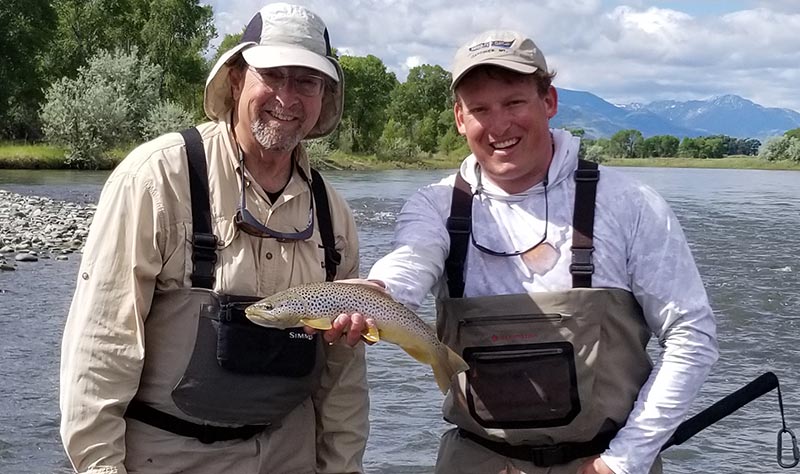
This brown came on the Yellowstone River during a runoff break around June 20, 2019, right before the river blew out again. The Yellowstone did not drop into fishable shape for good until July 7 that year.
Other good guided trip options this time of year are our power boat trips and private lake trips. As a matter of fact, this is the one period when these alternative trips are definitely better choices than float trips if you want to fish from a boat. That said, for many anglers nothing can compete with drifting down a river on a boat propelled by oars. Read on for info on where and how we do it through most of May and June.
Late Spring Float Trips: Quick Facts and General Information
- Best Waters: The top rivers in late spring are the lower and upper Madison and the Missouri downstream of Holter Dam. The Jefferson can be good some years late in this period, and during cold spells the Boulder and Yellowstone can be amazing. These cold spells can’t be planned for and the fishing only lasts a day or two at a time, though.
- Three Top Reasons to Come in Late Spring: 1.) You are eager to fish the lower Madison River, 2.) You are eager to fish the Missouri River when it fishes “easiest,” if not “best,” or 3.) This is when you can come, and you would rather float a river than a lake or take a walk trip.
- Three Top Reasons to Avoid Late Spring: 1.) Most rivers are too high and muddy to float, particularly the Yellowstone and Stillwater, 2.) Crowds are high on the rivers that are floatable, and 3.) Except during hatches, dry fly fishing is poor.
- Perfect Clients: Clients of any skill level who are coming at this time of year and would rather float-fish a river than fish a river from a power boat or fish a lake.
- What Late Spring Does Best: Provides the best fishing of the season on the lower Madison and Missouri Rivers.
May and some portion of June is runoff season in Montana, when the high mountain snow melts at last and turns every river, stream, creek, trickle, and rivulet that isn’t immediately downstream of a large dam into a raging chocolate brown torrent full of sticks, logs, and debris up to and including dead livestock and game animals. Sometimes this period even extends into early July, though with the effects of global warming this happens less and less often.
Needless to say, this is not the time to float freestone rivers, as rivers that aren’t protected by dams are known. It’s not that the fishing is so-so. It’s that the rivers are dangerous to even float, much less fish.
There are a few rivers that remain good at this time within our operations area. The Lower and to a lesser extent the Upper Madison are closest to Livingston. The Missouri River downstream of Holter Dam near Craig and Wolf Creek, Montana is further afield, but probably the best overall option. In fact this is usually the best period on the Missouri overall, provided anglers are willing to fish deep with nymphs to rack up the numbers if the trout aren’t rising. The crowds that swarm the “MO” at this time attest to the quality of the fishing.
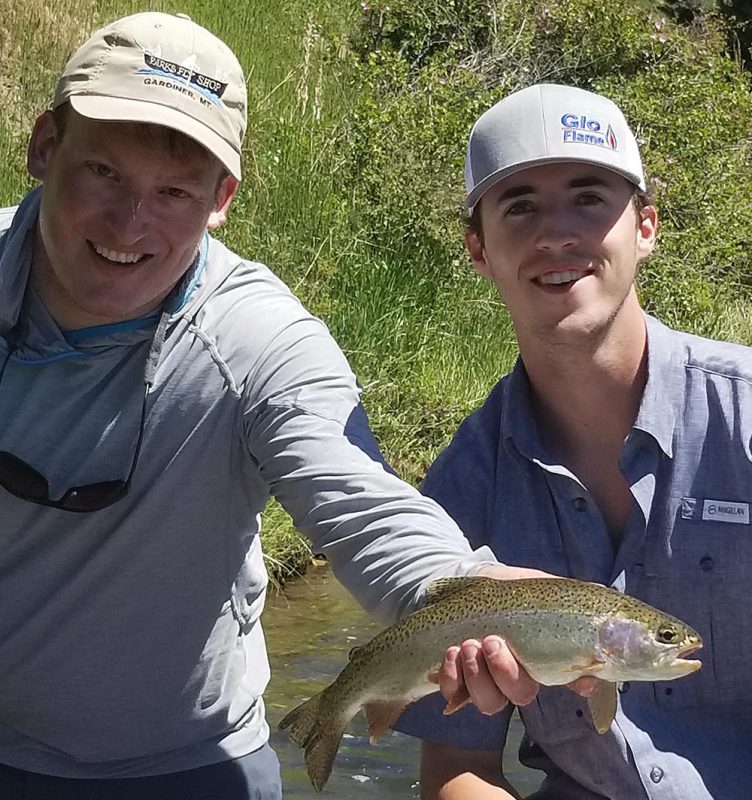
This Lower Madison rainbow trout ate a caddis pupa suspended beneath a dry. This is one of the larger fish you can expect from the Lower Madison using this technique rather than fishing deep with crayfish or imitations of other large food items.
Our primary float trip option in late spring is the Lower Madison River, which is located about 30 minutes from Bozeman, about an hour from Livingston. We also run a few trips on the Upper Madison and multi-day trips on the Missouri, most of the latter with repeat clients.
Crowds on all rivers low and clear enough to float in late spring are generally high. There’s just no getting around it. Lots of people come to Montana expecting everything to be good in May and early June, as it is in many other parts of the country, and they are all clustered onto fewer rivers than usual. The Missouri gets hit hard, in particular.
Late Spring Float Trips on the Lower Madison
On the Lower Madison, most large trout get caught on streamers, crayfish imitations, and San Juan Worms. Sometimes the highest numbers of trout also take these flies, but the Lower Maddy is an insect factory by mid-late May and most days see good insect hatches from sometime in mid-late morning through evening.
Caddis hatches in particular often blanket the river, as the photo below can attest. There can also be several species of mayflies as well as stoneflies. Because of all the bugs, we typically have clients fish dries and dry-dropper combos when feasible. The best dry and dry-dropper fishing here occurs when cloud cover is heavy. The Lower Madison is a shallow stretch of river, so the fish often don’t rise when the sun’s bright for fear of ospreys and eagles.
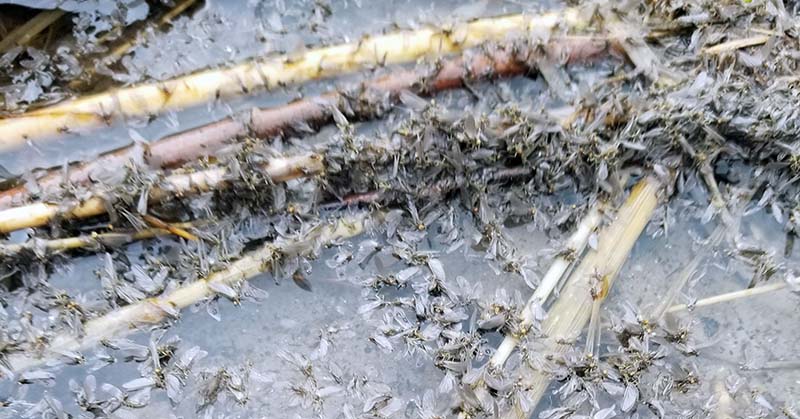
Vast numbers of caddisflies on the Lower Madison.
Most rising trout on the Lower Madison run small. The fish above was a very good rainbow for the dry-dropper technique. Most fish caught this way except during ideal weather conditions will run smaller. Small browns and rainbows are most common, but there are also good numbers of westslope cutthroat now, a new addition to the Lower Madison in the past few years. Like all cutthroat trout, these westslopes like to rise. They average a bit larger than most of the rainbows and browns we see rising. The fish below is a good example.
Half-day and full-day trips are available on the Lower Madison, and both trip types make a good deal of sense. Full-day trips allow us to get out in front of the crowds, while half-days will allow us to slot in well behind everybody to “match the hatch” on the upper end of the Lower Madison most guides are well past when the fish start rising. The Lower Madison tends to be crowded, but we can shed a lot of these crowds by getting out in front of them or staying on late.
We often fish quite slowly on Lower Madison floats, especially when the trout start rising. There are many good riffles and islands where the guide can stop the boat to let anglers work to pods of rising fish, and anglers so inclined also have the opportunity to get out and wade fish good spots. In general, we’ll fish a longer float and move faster when fish aren’t likely to rise, and fish slow and methodical when the weather and water conditions look conducive to hatches.
>>>>>>>>>>>>>> Return to Float Trips Page
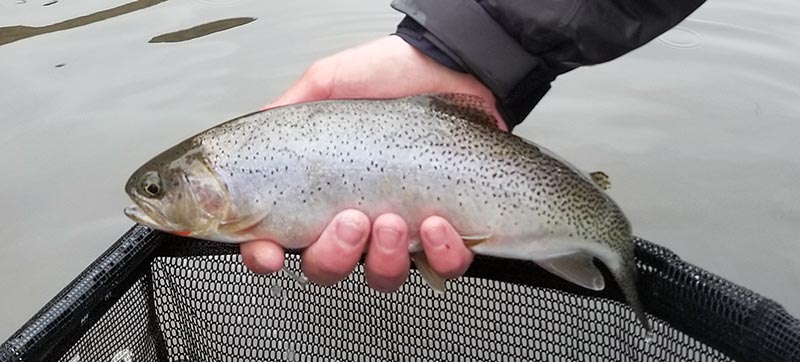
Average westslope cutthroat from the Lower Madison. The numbers of these native trout are increasing due to a successful reintroduction effort.
Float Trips in Early Spring
Posted on January 23rd, 2024
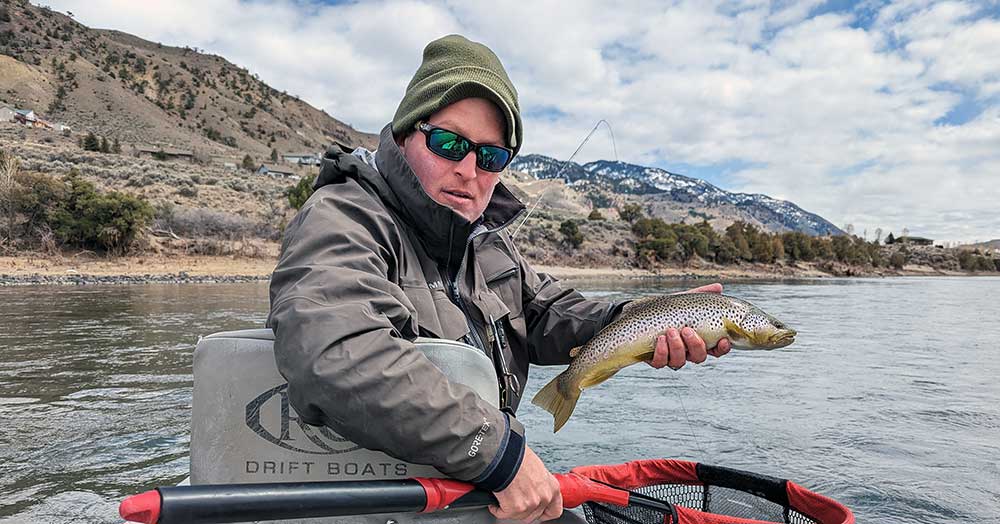
Early spring is prime season for larger fish.
Early Spring Float Trips: Introduction
Early spring float fishing in Montana is the best-kept secret in area fly fishing. Larger rivers fish very well at this time as the trout wake up from the long winter. Some dry fly fishing is possible, but the real draw is targeting big fish using subsurface tactics.
Angler crowds are minimal, the big fish are on the hunt, and there’s even a shot at dry fly fishing when it’s warm (or skiing at Bridger Bowl or Big Sky on off days, if it’s cold). What’s not to love?
The weather and water conditions, mostly. It might be bitter cold and snowing, it might be warm with howling winds. The rivers might be crystal clear or they might be chocolate brown with an early taste of the spring melt. These are the dice you roll when you book an early spring float trip. Not daunted? Read on.
Early Spring Float Trips: Quick Facts
- Best Waters: The top rivers in early spring are the entire Yellowstone except the shallowest stretches of Paradise Valley, and perhaps the lower Madison and Boulder Rivers.
- Three Top Reasons to Come in Early Spring: 1.) This is prime time for larger fish, especially rainbow and rainbow-cutthroat hybrid (cuttbow) trout. 2.) Crowds are low to nonexistent on most rivers. 3.) The fishing in early spring is just different than it is the rest of the year.
- Three Top Reasons to Avoid Early Spring: 1.) Dry fly fishing is limited. 2.) Weather and water conditions are inconsistent (it might be 15 degrees and snowing sideways, 50 with good fishing conditions, or 80 and sunny with a chocolate milk river). 3.) Fewer fisheries are good in early spring than during peak season.
- Perfect Clients: Experienced anglers eager to accept inconsistent weather and water conditions to fish nymphs and streamers for high-average and potentially really big fish, without the fishing crowds of summer and fall. Early spring is especially good for anglers who’ve been to Montana in the summer or early fall and want to see something different.
- What Early Spring Does Best: Produces good numbers of larger rainbows and some browns using indicator-nymphing techniques.
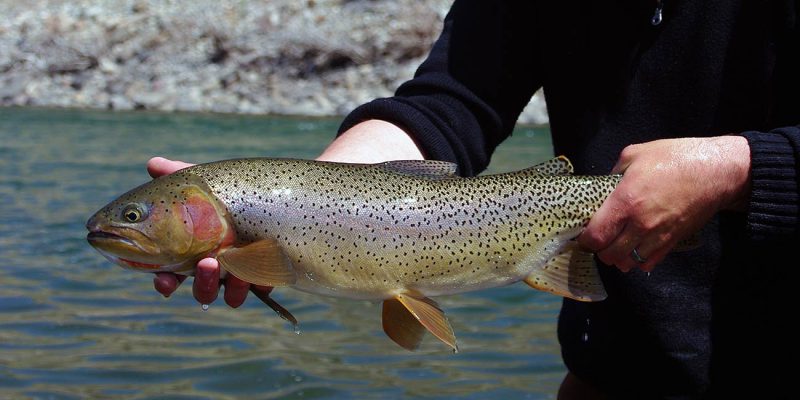
The largest rainbow and rainbow-cutthroat hybrid trout we see on the Yellowstone River are often caught on early spring float (or float-wade) trips. We got three this size in about two weeks, including two in one day.
Early Spring Float Trips: The Fishing
Early spring begins when the winter ice recedes enough to make floating safe and lasts until the heavy spring runoff hits freestone rivers like the Yellowstone sometime in early May, or once in a while the last few days of April.
This is the last truly “underfished” time of year in most areas within our operations area. On most rivers, we’re unlikely to see another boat during this period. Even on the Lower Madison, which sees the most pressure at this time of year, we’re unlikely to see more than a handful.
Despite the lack of pressure, this is a great time of year to float area rivers. The trout have the feedbags on to recover from the rigors of winter and the rainbow and cutthroat trout are preparing to spawn in tributary creeks, and are therefore aggressive.
It’s not uncommon for the largest fish of the year to come at this time, particularly rainbows. Because the crowds are low and the shots at big fish, we do more “personal” fishing on the Yellowstone River in early spring than during the rest of the year combined. One glorious day in late March Walter caught two fish over 23 inches long in an hour on the Yellowstone, and he never saw another angler or boat that day. Need we say more?
Early spring tactics are primarily subsurface. Our usual technique is to nymph with a big stonefly trailing something smaller, with a streamer rod at the ready as a changeup option.
The fish often gather in big numbers in small areas at this time, whether they’re sitting out the winter cold in pods or preparing for their spawning runs. For this reason, in early spring we often stop the boat and fish small areas hard, either anchored up or by using the boat mostly as transportation, then getting out to fish the likely spots on foot.
Unlike during the summer and early fall periods, we never fish dries in early spring unless we see rising fish. With the water still in the 30s or 40s, the fish simply don’t want to burn the energy to rise unless there are enough bugs to make it worthwhile. That said, the last few days of early spring on the Yellowstone can see some of the best dry fly fishing of the year.
This is the fabled Mother’s Day caddis hatch. This bug comes off in the millions or billions and drives the fish wild, provided the river is clear. This is a tough hatch to plan for, as often the river blows out with runoff right at the beginning of the hatch, but if you can hit it right, this might be one of the best days of fishing of your life.
Note that the Yellowstone does get crowded when the caddis pop, because every other guide in the state knows that this event causes spectacular fishing, too.
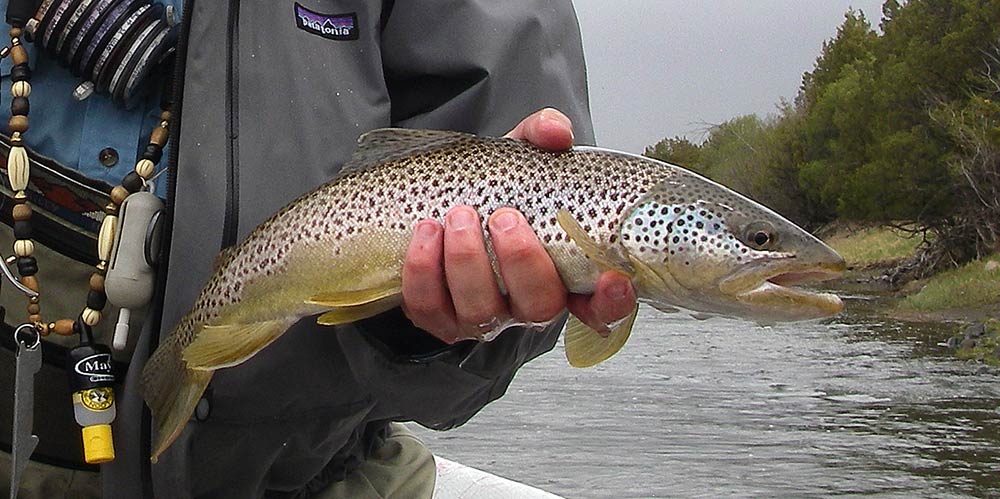
Large trout of all species often put on the feedbags right at the beginning of spring runoff. Walter caught this brown on the last day the river was clear enough to fish before blowing out for the spring melt. Notice how brown the water is in the background.
Early Spring Float Fishing in Montana: Where?
By far our favorite river to guide in early spring is the Yellowstone. It is clear most of the time, though warm weather can muddy it for a day or two as low-elevation snow melts, especially when the warm weather is accompanied by rain.
When the Yellowstone does get some early mud, the lower Madison is a great option. Further afield, the Missouri below Holter Dam is always great in early spring, and sees less traffic now than it does a few weeks later. The Boulder River is too cold through most of early spring, but it gets warm enough and high enough to float in late April and stays clear about a week later than the Yellowstone does, which makes it a great secondary option.
The major downside of early spring is the weather. “Spring” in Montana is not like spring in warmer places. It might be 15 degrees in the morning. It might snow all day. Worse, it might spit a mix of rain and snow. The wind often howls. It might also be 80 degrees and turn the rivers filthy with early snowmelt down from the mountains.
Floating can therefore be rather uncomfortable when the weather is bad, and the fishing can be unproductive when the weather is “good.” The somewhat variable water and weather conditions carry over to the fishing: it’s not consistent. Sometimes it’s great, but it can be tough too, especially if you’re after big numbers of fish rather than larger fish.
During early spring, half-day trips are better choices that full-days most of the time. This is especially true in March. Later in April, and especially in the few days of May before the runoff hits, the water warms and the fish get more aggressive, meaning full days are also a great option. Regardless of trip duration, we won’t meet early. There’s seldom any need to be on the water before 10:00AM.